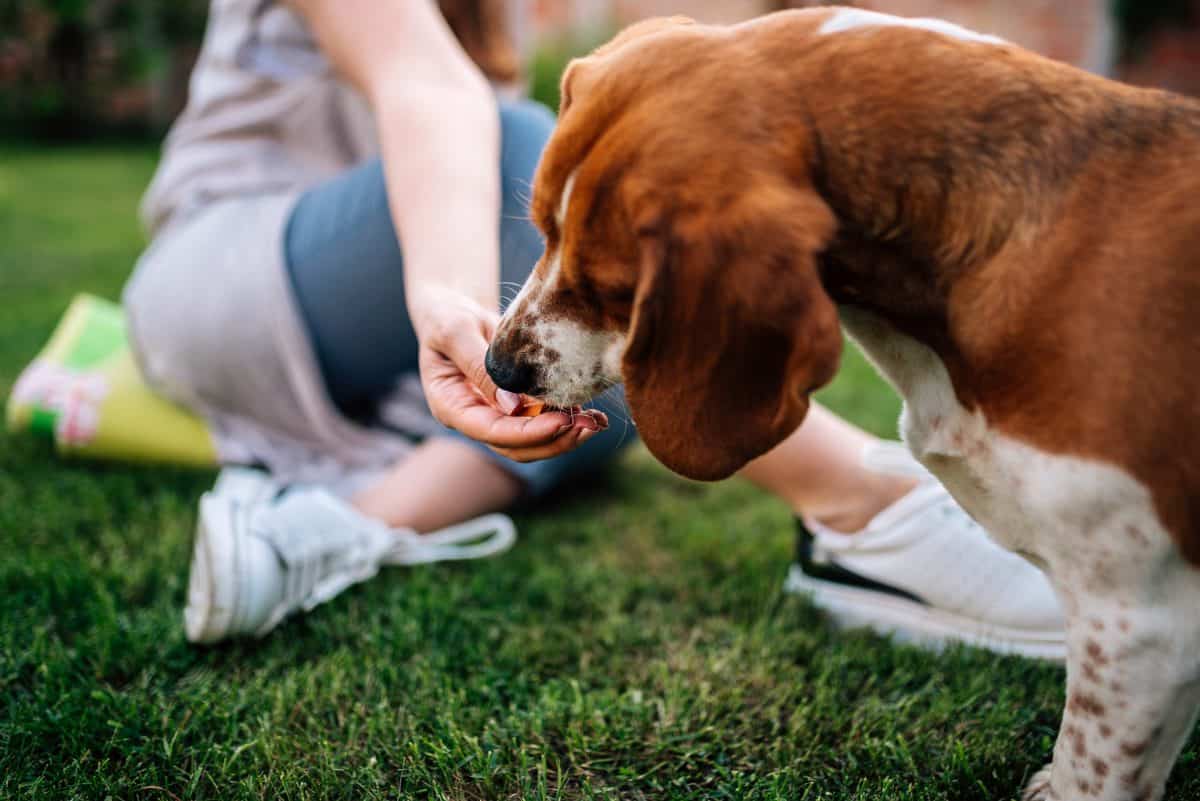What is Positive Reinforcement (R+) Dog Training?

When talking about training dogs, there are a handful of methodologies out there, and they have varying degrees of success when measuring desired results and side effects. Positive reinforcement dog training is the primary methodology taught at The Academy of Pet Careers. Not only do we believe it is the most effective method of training, but results have shown that it helps to create a longer lasting positive relationship with your pet.
That being said, positive reinforcement is a complex psychological process that can be difficult to understand. Let us help you understand the science behind the method so you can decide for yourself if this is the method you wish use for training.
Understanding Canine Learning Theory & Operant Conditioning
Learning theory explains how all animals (including humans) receive, process, and retain knowledge. You’ve probably heard of classical conditioning, the process of pairing a pleasant stimulus with a neutral stimulus (ie. ringing a bell when it’s time to feed your dog so they start to get excited when they hear a bell).
Aside from classical conditioning, humans and animals primarily use operant conditioning to learn. Operant conditioning is what happens when we make a conscious decision to act on our environment. Compared to classical conditioning which focuses on associations, operant conditioning teaches that actions have consequences, and we can make a choice that affects the outcome of a situation.
In dog training, we use classical conditioning to acclimate dogs to new environments and situations. For example, we give dogs treats during thunderstorms to create a positive association with the sound of thunder.
We use operant conditioning when teaching voluntary behaviors and skills. We might give a dog a treat when they sit or come when called. Through operant conditioning, we can encourage dogs to perform wanted behaviors or discourage them from performing undesired behaviors.
It’s important to remember that aversive training techniques also fall under the umbrella of operant conditioning, but research shows that it is not as effective as positive reinforcement dog training and can put your dog’s welfare at risk.
The Four Quadrants of Operant Conditioning
There are four methods of operant conditioning that are commonly referred to as “The Four Quadrants”.
Positive Reinforcement (R+)
As our primary focus, this method adds something the dog wants (+) to increase the likelihood of a desired behavior (R). An example is when you giving a dog a treat when it sits and the behavior increases.
Negative Reinforcement (R-)
This method removes something the dog dislikes (-) to increase the likelihood of a desired behavior (R). An example of this is when a dog stops pulling on its leash and the pressure from the collar decreases.
Negative Punishment (P-)
Next, this method removes something the dog wants (-) to decrease the likelihood of an undesired behavior (P). An example of this is when you remove your attention when a dog jumps on you to decrease the behavior.
Positive Punishment (P+)
Finally, this method adds something the dog dislikes (+) to decrease the likelihood of an undesired behavior (P). An example of this is adding a correction when a dog barks to decrease the behavior.
Every dog trainer, whether they know it or not, utilize all four quadrants of operant conditioning. The main difference for trainers who call themselves “positive”, “force-free”, or “reward-based” is that they focus primarily on positive reinforcement.
On the other hand, “traditional” or “balanced” dog trainers primarily focus on positive punishment. As explained earlier, all methods will teach a dog new skills, but they should not be considered equal to any degree.
Benefits of Positive Reinforcement Dog Training
The benefits of positive reinforcement training are truly too many to count, but here are a few of the most prominent ones:
- It creates an active thinker. Because dogs are rewarded for the correct behavior, they learn to offer behaviors to get more rewards (active thinking). Traditional training doesn’t train the pet what to do, only what NOT to do. Such methods develop a reactive thinking dog that is fearful of trying new things. Such dogs come across as robotic or shut down.
- It builds confidence. An active thinking dog that has been socialized to their environment is a confident dog. Confidence is hugely important in the lifelong happiness of a pet. Confident pets have a reduced chance of developing codependent behaviors. They are also better socialized and have a reduced risk of being relinquished.
- It improves skill retention. When dogs are given a choice, their minds are more actively focused on the task at hand. This allows skills and behaviors to better engrain in their memory. Skills learned through positive reinforcement training have been proven to last longer and require less maintenance down the road.
- It facilitates better communication. The human-pet bond is strengthened. The reward becomes the motivator, instead of the fear of a correction. This creates engagement with the handler and builds trust between the two. This engagement becomes the foundation of success for all future training.
- It decreases the chances of anxiety and stress. When you use aversive methods, you naturally add to your dog’s discomfort and stress. Plus, you run the risk of creating unintended negative associations, which can lead to your dog having a less optimistic view of the world around them.
- It’s fun, engaging mental stimulation. Dogs love to learn new skills. And the more you train your dog, the more they’ll enjoy the process.
Examples of Positive Reinforcement Dog Training
Let’s break down a few examples of how positive reinforcement can be used to manage and teach different behaviors.
Housetraining a Puppy
Desired behavior: Puppy potties outside in the yard instead of in the house.
In this case, you would reward your puppy for pottying outside. To speed up the learning process, give them fewer opportunities to potty inside the house. This means paying attention to your puppy’s signals and taking them outside when they start circling or sniffing at the floor. Let the puppy potty outside, and immediately mark and reward the behavior.
Training a Recall
Desired behavior: Dog comes when called.
Recall is possibly the skill that pet owners struggle with the most. Choose a very high-value reward, like cheese or hot dog slices. Call your dog and reward them for coming to you. Start small with just a few feet between you and your dog, and slowly work your way up to greater distances. It’s important to limit the likelihood that your dog will “fail” the skill, so start in low-distraction environments.
Teaching Polite Greetings
Desired behavior: Dog sits upon greetings instead of jumping on guests.
When greeting your dog, wait for them to settle down and lure or cue them into a sitting position. Mark and reward. Keep practicing every time you come home from work and encourage houseguests to do the same. When your dog does jump on you, shift your body away from them and do not give them attention (an example of negative punishment).
Become a Positive Reinforcement Dog Trainer
If you want to become a dog trainer, positive reinforcement is the way to go. Pet owners are more aware than ever about what their dogs need. They want to form strong, lasting relationships with their dogs, and positive reinforcement is the way to do it.
When it’s time to communicate with clients, you’ll find that positive reinforcement is a much easier sell than punishment-based methods. You get to help your clients build relationships with their pets, treat their pets kindly, and make training fun. Who doesn’t want that for their pet?
The Academy of Pet Careers offers both online and in-person dog training programs designed to provide you with the hands-on education you need to jumpstart your dog training career.
 Author - Joseph Schifano
Author - Joseph Schifano
Joseph Schifano is the owner and President of The Academy of Pet Careers. With over 20 years of experience working in the pet field, managing large scale pet care businesses, he has experience in every facet of the industry. Joseph's focus is primarily on the business of pet care but his passion is in understanding animal behavior how a dog's brain works so we can improve the care we provide as pet professionals. He is a huge advocate for Pet Empowerment and Force Free training methods. Read more in Joseph's full bio.
